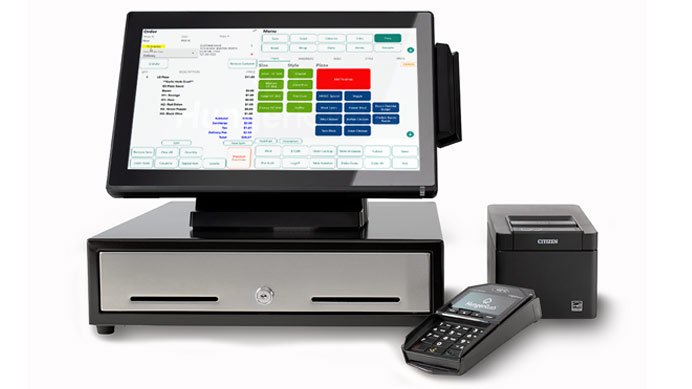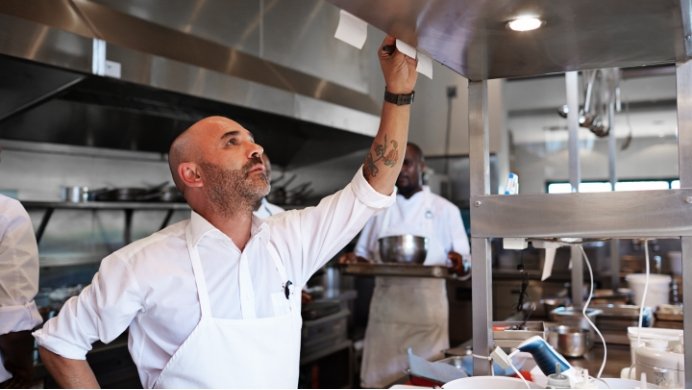The US restaurant industry has developed a universal language that is used in almost every dine-in restaurant. This unique lexicon is a spicy blend of code words, phrases, and sometimes expletives.
Generations of restaurant staff have used industry jargon to communicate efficiently on and off the clock.
In fact, with the popularity of shows such as FX's The Bear, restaurant terminology is more mainstream than ever!
Whether you are new to the industry or just a curious customer, understanding this secret language will help you navigate the fast-paced world of restaurants.
Fortunately, there are a lot of former servers, restaurant managers, bartenders, and chefs on the HungerRush team, so we asked them to translate 25 common restaurant phrases.
Read on to learn common industry terms and finally understand what "HEARD" means!
Defining Restaurant Terms and Phrases
1. 2-top, 4-top, 8-top, etc.
Simply put, a 2-top is a table that seats two guests. A 4-top has four guests, and a 6-top has, you guessed it, six guests. This term is used by hosts and servers to communicate about particular tables.
"Do you mind bringing my 2-top more water?"
2. 86
Kat Willis, a restaurant owner and Menufy client specialist, has a simple way of explaining one of the most well-known industry terms: "'86 is just shorthand for 'heads up, we are out of this thing.'"
Usually, that 'thing' is an ingredient, drink, or special menu item. Once something is 86'd, the restaurant staff will spread the word among themselves or even remove the item from their POS (point of sale, we will get into this term later).
“86 the chicken special. We just sold the last one to an online order.”
3. All day
Any fan of The Bear has probably heard the phrase "all day" numerous times during high-intensity kitchen scenes. It refers to the total number of orders of a certain dish that the kitchen needs to make at that particular time. Instead of separately reading out each individual order for the same dish, restaurant staff will streamline the process by totaling the orders and ending with "all day," which means "all together." Since the phrase comes at the end, it also signals the end of the message, like saying "over" on a radio.
"We need nine hot mozzarella sticks ALL DAY!"
4. Back of house
The back of house, also known as BOH, is the group of restaurant staff who generally don’t interact with customers. This includes positions such as dishwashers, prep cooks, and even the chef. BOH can also refer to the literal back of the restaurant, like a supply closet or dry ingredient storage.
"We need extra BOH staff to handle Mother's Day brunch rush."
5. Behind
Restaurants are often bustling with staff carrying trays of glasses or hot plates. In order to avoid a full-speed collision, employees announce their presence by calling out "behind" when passing behind a coworker. Think of it as an expedited way of saying, "I am right behind you, so don't run into me, please."
"Kathy forgot to say 'behind,' so I ran right into her, causing me to spill a plate of bolognese on a customer's lap!"
6. Campers
Anyone who has worked in a restaurant knows the struggle of dealing with a camper. If you haven't worked in a restaurant, learning this term can help you be respectful of restaurant workers.
Ashley Day, a Menufy sales manager and former restaurant general manager, was passionate when explaining what a camper means in restaurant slang. "Camper = ugh! Campers can be customers who have paid their check but are not leaving, making it impossible to make NEW money until they skedaddle. Campers can also be people who want to sit at your table but don't plan on ordering anything other than their free water, or maybe they already got ONE drink from the bar and are 'fine.' It's restaurant code to either keep ordering while at a table/bar spot or pay your check and move out!"
"The campers at my 6-top are taking up precious real estate!"
7. Comp
A dish or drink that is comped is given to a guest free of charge. Usually, a manager will comp an item if it was deemed not up to standards or if they want to smooth over an extremely poor service experience. Comping also happens when a restaurant is trying to impress a notable customer or celebrate a special occasion, such as a 50th wedding anniversary.
“I had to comp a customer a bottle of wine because I spilled a plate of bolognese on them.”
8. Corner
"Corner" is similar to the phrase "behind." Restaurant staff often yell this when they’re rounding a corner. This alerts anyone who might be in the way to move it!
“Corner!”
9. Cut
Lukus Estok owns a restaurant in NYC and serves as HungerRush's project manager. He explained what it means to get cut, which is not as scary as it sounds.
"The term 'cut' is pretty self-explanatory. You cut things you don't need. You set them free, let them go! And to a financially-minded manager, sending people home saves on labor costs."
Usually, a restaurant employee will get cut when a dining rush has slowed down.
“Yeah, I was going to work until 7, but we were soooo slow that the manager cut me."
10. Double-sat
A server is double-sat (or even triple-sat) when they are responsible for multiple sets of guests who have been seated at the same time. Most of the time, each group of diners in a server's section is at a different point in their dining journey. But servers who are double-sat have to juggle taking care of multiple groups that have the same needs at the same time—such as being greeted or given menus or having their drinks order taken. This can be a stressful situation for servers, and it sometimes leaves one table waiting longer than a server would like.
"The host just double-sat me, so now I have two tables that need menus and water."
11. Double
When a restaurant employee works two shifts back-to-back, it is known as working a double.
“My feet are about to fall off. I’ve only worked doubles this week."
12. Expo
The expo, short for "expeditor," is a position tasked with ensuring that each dish has any finishing touches, such as garnish or specific cutlery, before it is taken out to a table. The expo acts as an intermediary between the kitchen and the dining room and is often a restaurant manager.
“We didn't have anyone on expo last night, so most of the steaks went to the tables without steak knives."
13. Family meal
According to Kat Willis, a family meal is almost exactly what it sounds like. "Family meal is a free communal meal, sometimes before or after the shift, where the entire team is fed together. It's a time to bond and talk about the upcoming week/shifts/events."
Traditionally, family meals are an opportunity for the kitchen to use up leftovers or unused ingredients. Sometimes these meals are a chance for the staff to try new menu items or potential recipes.
"I can't wait for family meal so that I can try the special dishes for the upcoming summer menu!"
14. Fire
The word "fire" is not something you usually want to hear while in the kitchen. But in the restaurant world, it is used to let the kitchen staff know it’s time to start cooking or prepping a dish. Generally, this phrase is reserved for the head chef or whoever is in charge of the kitchen.
"Fire those pizzas so they are ready when the large party arrives.”
15. Front of house
The front of house (FOH) is the opposite of the back of house. The FOH is a place and a classification of employees. The front of house is where customers are found at a restaurant, such as the online order pickup station or the dining room. FOH employees will almost always be responsible for interacting with customers. FOH employees include servers, hosts, and bussers.
"A customer just left a review complimenting the FOH staff's outstanding service."
16. Hands
When finalized dishes are complete, a chef will use the call to action "hands" to summon any available staff to help deliver the food to hungry guests. Most often, this term is used when there is a build-up of ready-to-go dishes that need to go out while they're hot!
"HANDS! There are six entrees ready to go right now!"
17. Heard
"Heard" is one of the most infamous phrases in restaurant lingo.
Ashley Day used the term countless times during her tenure in the restaurant industry. "'Heard' means, 'I am acknowledging what was said.' Typically, it's used when yelling out to the staff when items are 86'd."
"HEY! WE'RE 86 ON THE MEATLOAF!"
"Heard."
18. High-top
High-tops are tables that are taller than standard dining tables. It is standard practice for bar areas to use high-top tables with stools for seating.
"The bar area high-top tables are first come, first served."
19. In the weeds
If a restaurant employee is in the weeds, they usually are not having a smooth shift. Mar Garcia, a Menufy sales manager and former restaurant manager, knows too well the struggle of being in the weeds.
“When a server or bartender is behind, backed up, has too many things to do at once, can’t catch up, it means they are in the weeds.” This can happen when a restaurant has an unexpected rush, a server has been double-sat, or a large party is dominating a server's time.
"Can you please bring a side of ranch to my table? I am DEEP in the weeds right now."
20. On the fly
"On the fly" is the term for when a dish needs to be prepared as soon as possible. For example, when a dish is not cooked as ordered or a server forgets to put in an order, the phrase "on the fly" will prompt the kitchen to prioritize making that item.
"I need a gluten-free burger on the fly. The customer has a wheat allergy."
Image courtesy of HungerRush POS
21. POS
POS is an acronym of "point of sale." The POS is the computer system or software that restaurants use to input and manage orders. These systems can be as simple as an app on a tablet or as elaborate as a custom computer station.
"I forgot to ring in that order on the POS."
22. Rollup
Rollups are cutlery that is rolled into a paper or cloth napkin. They are usually assembled by restaurant staff at the start or end of a shift.
"To eliminate extra plastic, the customer requested that no rollups be included in their online order."
23. Side work
Most servers and other restaurant staff have to complete chores at the end of their shift. These chores are known as "side work." Examples include restocking napkins and straws or refilling condiment bottles. Side work ensures that the next shift is set up for success.
"My side work assignment is refilling the salt and pepper shakers. Then I can go home."
24. Ticket
After an order is input into a restaurant POS (point of sale), a receipt prints the details of the order. This receipt is known as a ticket. Traditionally, a ticket includes information such as a timestamp and any guest-requested moderations.
Depending on the order, the ticket will print in various areas of the restaurant. Each ticket alerts the bartender or chef that an order needs to be made.
“A ticket came in for an order of nacho fries."
Image courtesy of HungerRush
25. Walk-in
The term "walk-in" has a dual meaning in the restaurant world. It can refer to customers who "walk in" without a reservation, or it can mean a large "walk-in" fridge where perishable ingredients are kept.
"Can you organize the meat delivery in the walk-in?"
The Last Bite
While each restaurant has its unique vocabulary, these terms are the most commonly used throughout the industry.
If you work in food service, you need to understand the lingo to be an efficient member of the restaurant team.
Even if you don't work in a restaurant, knowing the language can help you be a better customer and avoid becoming a camper.
Are there any words or phrases that should have made the list? Let us know!
ABOUT THE AUTHOR
Melissa Dimmitt, Marketing Manager
Melissa began her digital marketing career nearly a decade ago at a restaurant group. She worked with restaurant managers and executive chefs while coordinating seasonal menu releases, executing photoshoots, and creating fresh digital content.







